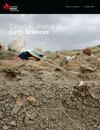加拿大魁北克Simard湖的地震反射地层学:Barlow-Ojibway冰川湖的物质流沉积
IF 1.6
4区 地球科学
Q3 GEOSCIENCES, MULTIDISCIPLINARY
引用次数: 0
摘要
Lac Simard是一个冰川覆盖的盾状盆地,位于魁北克西部地震带,这是一个经常发生板内地震活动的地区,包括几个人口稠密的地区。之前的研究表明,保存在湖盆中的沉积物有可能成为古地震活动的宝贵档案。相应地,在Lac Simard进行了高分辨率啁啾地震反射测量,结果显示了两个地层序列(SS-1和SS-2)中的四个声学相(Af-1至Af-4)。最底层的SS-1以高振幅、层状的Af-2为主,被解释为冰川消融后冰湖积水期间主要溢流和间流悬浮沉积的冰川阀。Af-2的悬浮沉积偶尔会被堆积的、混乱的层状、弱分级到不透明的、通道化的Af-3打断,这被解释为泥石流或高密度浊度流。af3区粉屑角砾岩的存在也表明盆地侧壁的下坡塌陷和阀门改造。上覆的SS-2以弱反射、层状、高频变异的Af-4为主,表明冰川后沉积存在持续的季节控制,但存在相对的沉积物饥饿。分离SS-1和冰川后SS-2的一个盆地范围的侵蚀不整合记录了大约8000年前巴洛-奥吉布韦冰川湖的突然排水。结合该地区湖底扰动的历史,认为Af-3块流相可能为发震相,具有区域构造意义。然而,我们不能排除由高度动态退缩的劳伦泰德冰盖的融水和沉积物突然流入引发大量流动的可能性。本文章由计算机程序翻译,如有差异,请以英文原文为准。
Seismic reflection stratigraphy of Lac Simard, Quebec, Canada: mass flow sedimentation in glacial Lake Barlow-Ojibway
Lac Simard is a glaciated Shield basin situated in the Western Quebec Seismic Zone, an area of recurrent intraplate seismicity encompassing several densely populated areas. Previous works nearby have demonstrated that sediments preserved in lake basins hold the potential to serve as valuable archives of paleoseismicity. Correspondingly, a high-resolution chirp seismic reflection survey was conducted in Lac Simard, with results showing four acoustic facies (Af-1 to Af-4) within two stratigraphic successions (SS-1 and SS-2). The lowermost SS-1 is dominated by high-amplitude, laminated Af-2, interpreted as lateglacial varves deposited by suspension from primarily overflows and interflows during glacial lake ponding following deglaciation. Suspension deposition of Af-2 was episodically interrupted by stacked, chaotically bedded, weakly graded to opaque, channelled Af-3 interpreted as either debris flows or high-density turbidity currents. Presence of silt-clast breccias in Af-3 also suggests downslope collapse and reworking of varves from basin sidewalls. The overlying SS-2 is dominated by weakly reflective, laminated, high-frequency varved Af-4, suggesting a continuing seasonal control on postglacial sedimentation but with relative sediment starvation. A basin-wide erosional unconformity separating SS-1 and postglacial SS-2 records the abrupt drainage of glacial Lake Barlow-Ojibway around 8 000 years ago. Considering the history of lake floor disturbance in the region, mass flow facies Af-3 may be seismogenic, and thus, have regional tectonic significance. However, we cannot rule out the possibility of mass flows triggered by abrupt inflows of meltwater and sediment from a highly dynamic retreating Laurentide Ice Sheet prone to surging.
求助全文
通过发布文献求助,成功后即可免费获取论文全文。
去求助
来源期刊

Canadian Journal of Earth Sciences
地学-地球科学综合
CiteScore
2.80
自引率
7.10%
发文量
66
审稿时长
6-12 weeks
期刊介绍:
The Canadian Journal of Earth Sciences reports current research in climate and environmental geoscience; geoarchaeology and forensic geoscience; geochronology and geochemistry; geophysics; GIS and geomatics; hydrology; mineralogy and petrology; mining and engineering geology; ore deposits and economic geology; paleontology, petroleum geology and basin analysis; physical geography and Quaternary geoscience; planetary geoscience; sedimentology and stratigraphy; soil sciences; and structural geology and tectonics. It also publishes special issues that focus on information and studies about a particular segment of earth sciences.
 求助内容:
求助内容: 应助结果提醒方式:
应助结果提醒方式:


